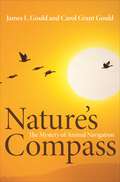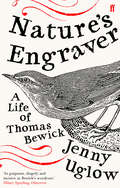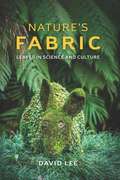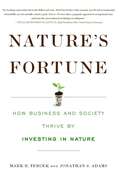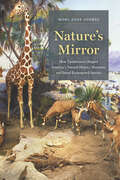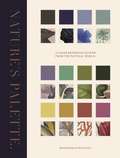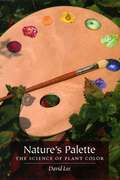- Table View
- List View
Nature's Compass: The Mystery of Animal Navigation
by James L. Gould Carol Grant GouldWe know that animals cross miles of water, land, and sky with pinpoint precision on a daily basis. But it is only in recent years that scientists have learned how these astounding feats of navigation are actually accomplished. With colorful and thorough detail, Nature's Compass explores the remarkable methods by which animals find their way both near home and around the globe. Noted biologist James Gould and popular science writer Carol Gould delve into the elegant strategies and fail-safe backup systems, the invisible sensitivities and mysterious forces, and incredible mental abilities used by familiar and rare species, as they investigate a multitude of navigation strategies, from the simple to the astonishing. The Goulds discuss how animals navigate, without instruments and training, at a level far beyond human talents. They explain how animals measure time and show how the fragile monarch butterfly employs an internal clock, calendar, compass, and map to commence and measure the two-thousand-mile annual journey to Mexico--all with a brain that weighs only a few thousandths of an ounce. They look at honey bees and how they rely on the sun and mental maps to locate landmarks such as nests and flowers. And they examine whether long-distance migrants, such as the homing pigeon, depend on a global positioning system to let them know where they are. Ultimately, the authors ask if the disruption of migratory paths through habitat destruction and global warming is affecting and endangering animal species. Providing a comprehensive picture of animal navigation and migration, Nature's Compass decodes the mysteries of this extraordinary aspect of natural behavior.
Nature's Engraver: A Life of Thomas Bewick
by Jenny UglowThomas Bewick wrote A History of British Birds at the end of the eighteenth century, just as Britain fell in love with nature. This was one of the wildlife books that marked the moment, the first 'field-guide' for ordinary people, illustrated by woodcuts of astonishing accuracy and beauty. But it was far more than that, for in the vivid vignettes scattered through the book Bewick drew the life of the country people of the North East - a world already vanishing under the threat of enclosures.In this superbly illustrated biography, Jenny Uglow tells the story of the farmer's son from Tyneside who revolutionised wood-engraving and influenced book illustration for a century to come. It is a story of violent change, radical politics, lost ways of life and the beauty of the wild - a journey to the beginning of our lasting obsession with the natural world. Nature's Engraver won the National Arts Writers Award in 2007. Jenny Uglow is the author of, among others, A Gambling Man: Charles II and the Restoration, which was shortlisted for the 2010 Samuel Johnson Prize, Lunar Men and In These Times. 'The most perfect historian imaginable' Peter Ackroyd
Nature's Fabric: Leaves in Science and Culture
by David LeeLeaves are all around us—in backyards, cascading from window boxes, even emerging from small cracks in city sidewalks given the slightest glint of sunlight. Perhaps because they are everywhere, it’s easy to overlook the humble leaf, but a close look at them provides one of the most enjoyable ways to connect with the natural world. A lush, incredibly informative tribute to the leaf, Nature’s Fabric offers an introduction to the science of leaves, weaving biology and chemistry with the history of the deep connection we feel with all things growing and green. Leaves come in a staggering variety of textures and shapes: they can be smooth or rough, their edges smooth, lobed, or with tiny teeth. They have adapted to their environments in remarkable, often stunningly beautiful ways—from the leaves of carnivorous plants, which have tiny “trigger hairs” that signal the trap to close, to the impressive defense strategies some leaves have evolved to reduce their consumption. (Recent studies suggest, for example, that some plants can detect chewing vibrations and mobilize potent chemical defenses.) In many cases, we’ve learned from the extraordinary adaptations of leaves, such as the invention of new self-cleaning surfaces inspired by the slippery coating found on leaves. But we owe much more to leaves, and Lee also calls our attention back to the fact that that our very lives—and the lives of all on the planet—depend on them. Not only is foliage is the ultimate source of food for every living thing on land, its capacity to cycle carbon dioxide and oxygen can be considered among evolution’s most important achievements—and one that is critical in mitigating global climate change. Taking readers through major topics like these while not losing sight of the small wonders of nature we see every day—if you’d like to identify a favorite leaf, Lee’s glossary of leaf characteristics means you won’t be left out on a limb—Nature’s Fabric is eminently readable and full of intriguing research, sure to enhance your appreciation for these extraordinary green machines.
Nature's Fabric: Leaves in Science and Culture
by David LeeLeaves are all around us—in backyards, cascading from window boxes, even emerging from small cracks in city sidewalks given the slightest glint of sunlight. Perhaps because they are everywhere, it’s easy to overlook the humble leaf, but a close look at them provides one of the most enjoyable ways to connect with the natural world. A lush, incredibly informative tribute to the leaf, Nature’s Fabric offers an introduction to the science of leaves, weaving biology and chemistry with the history of the deep connection we feel with all things growing and green. Leaves come in a staggering variety of textures and shapes: they can be smooth or rough, their edges smooth, lobed, or with tiny teeth. They have adapted to their environments in remarkable, often stunningly beautiful ways—from the leaves of carnivorous plants, which have tiny “trigger hairs” that signal the trap to close, to the impressive defense strategies some leaves have evolved to reduce their consumption. (Recent studies suggest, for example, that some plants can detect chewing vibrations and mobilize potent chemical defenses.) In many cases, we’ve learned from the extraordinary adaptations of leaves, such as the invention of new self-cleaning surfaces inspired by the slippery coating found on leaves. But we owe much more to leaves, and Lee also calls our attention back to the fact that that our very lives—and the lives of all on the planet—depend on them. Not only is foliage is the ultimate source of food for every living thing on land, its capacity to cycle carbon dioxide and oxygen can be considered among evolution’s most important achievements—and one that is critical in mitigating global climate change. Taking readers through major topics like these while not losing sight of the small wonders of nature we see every day—if you’d like to identify a favorite leaf, Lee’s glossary of leaf characteristics means you won’t be left out on a limb—Nature’s Fabric is eminently readable and full of intriguing research, sure to enhance your appreciation for these extraordinary green machines.
Nature's Fabric: Leaves in Science and Culture
by David LeeLeaves are all around us—in backyards, cascading from window boxes, even emerging from small cracks in city sidewalks given the slightest glint of sunlight. Perhaps because they are everywhere, it’s easy to overlook the humble leaf, but a close look at them provides one of the most enjoyable ways to connect with the natural world. A lush, incredibly informative tribute to the leaf, Nature’s Fabric offers an introduction to the science of leaves, weaving biology and chemistry with the history of the deep connection we feel with all things growing and green. Leaves come in a staggering variety of textures and shapes: they can be smooth or rough, their edges smooth, lobed, or with tiny teeth. They have adapted to their environments in remarkable, often stunningly beautiful ways—from the leaves of carnivorous plants, which have tiny “trigger hairs” that signal the trap to close, to the impressive defense strategies some leaves have evolved to reduce their consumption. (Recent studies suggest, for example, that some plants can detect chewing vibrations and mobilize potent chemical defenses.) In many cases, we’ve learned from the extraordinary adaptations of leaves, such as the invention of new self-cleaning surfaces inspired by the slippery coating found on leaves. But we owe much more to leaves, and Lee also calls our attention back to the fact that that our very lives—and the lives of all on the planet—depend on them. Not only is foliage is the ultimate source of food for every living thing on land, its capacity to cycle carbon dioxide and oxygen can be considered among evolution’s most important achievements—and one that is critical in mitigating global climate change. Taking readers through major topics like these while not losing sight of the small wonders of nature we see every day—if you’d like to identify a favorite leaf, Lee’s glossary of leaf characteristics means you won’t be left out on a limb—Nature’s Fabric is eminently readable and full of intriguing research, sure to enhance your appreciation for these extraordinary green machines.
Nature's Fabric: Leaves in Science and Culture
by David LeeLeaves are all around us—in backyards, cascading from window boxes, even emerging from small cracks in city sidewalks given the slightest glint of sunlight. Perhaps because they are everywhere, it’s easy to overlook the humble leaf, but a close look at them provides one of the most enjoyable ways to connect with the natural world. A lush, incredibly informative tribute to the leaf, Nature’s Fabric offers an introduction to the science of leaves, weaving biology and chemistry with the history of the deep connection we feel with all things growing and green. Leaves come in a staggering variety of textures and shapes: they can be smooth or rough, their edges smooth, lobed, or with tiny teeth. They have adapted to their environments in remarkable, often stunningly beautiful ways—from the leaves of carnivorous plants, which have tiny “trigger hairs” that signal the trap to close, to the impressive defense strategies some leaves have evolved to reduce their consumption. (Recent studies suggest, for example, that some plants can detect chewing vibrations and mobilize potent chemical defenses.) In many cases, we’ve learned from the extraordinary adaptations of leaves, such as the invention of new self-cleaning surfaces inspired by the slippery coating found on leaves. But we owe much more to leaves, and Lee also calls our attention back to the fact that that our very lives—and the lives of all on the planet—depend on them. Not only is foliage is the ultimate source of food for every living thing on land, its capacity to cycle carbon dioxide and oxygen can be considered among evolution’s most important achievements—and one that is critical in mitigating global climate change. Taking readers through major topics like these while not losing sight of the small wonders of nature we see every day—if you’d like to identify a favorite leaf, Lee’s glossary of leaf characteristics means you won’t be left out on a limb—Nature’s Fabric is eminently readable and full of intriguing research, sure to enhance your appreciation for these extraordinary green machines.
Nature's Fortune: How Business and Society Thrive by Investing in Nature
by Jonathan S. Adams Mark R. TercekWhat is nature worth? The answer to this question-which traditionally has been framed in environmental terms-is revolutionizing the way we do business.In Nature's Fortune, Mark Tercek, CEO of The Nature Conservancy and former investment banker, and science writer Jonathan Adams argue that nature is not only the foundation of human well-being, but also the smartest commercial investment any business or government can make. The forests, floodplains, and oyster reefs often seen simply as raw materials or as obstacles to be cleared in the name of progress are, instead, as important to our future prosperity as technology or law or business innovation.Who invests in nature, and why? What rates of return can it produce? When is protecting nature a good investment? With stories from the South Pacific to the California coast, from the Andes to the Gulf of Mexico and even to New York City, Nature's Fortune shows how viewing nature as green infrastructure allows for breakthroughs not only in conservation-protecting water supplies; enhancing the health of fisheries; making cities more sustainable, livable and safe; and dealing with unavoidable climate change-but in economic progress, as well. Organizations obviously depend on the environment for key resources-water, trees, and land. But they can also reap substantial commercial benefits in the form of risk mitigation, cost reduction, new investment opportunities, and the protection of assets. Once leaders learn how to account for nature in financial terms, they can incorporate that value into the organization's decisions and activities, just as habitually as they consider cost, revenue, and ROI. Such a rethinking of "natural capital”-nature as a quantifiable asset-can not only increase profitability, but provide crucial protection against the kinds of climate change-driven phenomena-like devastating drought and hundred-year floods-that are no longer the stuff of speculation.A must-read for business leaders, CEOs, investors, and environmentalists alike, Nature's Fortune offers an essential guide to the world's economic-and environmental-well-being.
Nature's Ghosts: Confronting Extinction from the Age of Jefferson to the Age of Ecology
by Mark V. Barrow, Jr.The rapid growth of the American environmental movement in recent decades obscures the fact that long before the first Earth Day and the passage of the Endangered Species Act, naturalists and concerned citizens recognized—and worried about—the problem of human-caused extinction. As Mark V. Barrow reveals in Nature’s Ghosts, the threat of species loss has haunted Americans since the early days of the republic. From Thomas Jefferson’s day—when the fossil remains of such fantastic lost animals as the mastodon and the woolly mammoth were first reconstructed—through the pioneering conservation efforts of early naturalists like John James Audubon and John Muir, Barrow shows how Americans came to understand that it was not only possible for entire species to die out, but that humans themselves could be responsible for their extinction. With the destruction of the passenger pigeon and the precipitous decline of the bison, professional scientists and wildlife enthusiasts alike began to understand that even very common species were not safe from the juggernaut of modern, industrial society. That realization spawned public education and legislative campaigns that laid the foundation for the modern environmental movement and the preservation of such iconic creatures as the bald eagle, the California condor, and the whooping crane. A sweeping, beautifully illustrated historical narrative that unites the fascinating stories of endangered animals and the dedicated individuals who have studied and struggled to protect them, Nature’s Ghosts offers an unprecedented view of what we’ve lost—and a stark reminder of the hard work of preservation still ahead.
Nature's Ghosts: Confronting Extinction from the Age of Jefferson to the Age of Ecology
by Mark V. Barrow, Jr.The rapid growth of the American environmental movement in recent decades obscures the fact that long before the first Earth Day and the passage of the Endangered Species Act, naturalists and concerned citizens recognized—and worried about—the problem of human-caused extinction. As Mark V. Barrow reveals in Nature’s Ghosts, the threat of species loss has haunted Americans since the early days of the republic. From Thomas Jefferson’s day—when the fossil remains of such fantastic lost animals as the mastodon and the woolly mammoth were first reconstructed—through the pioneering conservation efforts of early naturalists like John James Audubon and John Muir, Barrow shows how Americans came to understand that it was not only possible for entire species to die out, but that humans themselves could be responsible for their extinction. With the destruction of the passenger pigeon and the precipitous decline of the bison, professional scientists and wildlife enthusiasts alike began to understand that even very common species were not safe from the juggernaut of modern, industrial society. That realization spawned public education and legislative campaigns that laid the foundation for the modern environmental movement and the preservation of such iconic creatures as the bald eagle, the California condor, and the whooping crane. A sweeping, beautifully illustrated historical narrative that unites the fascinating stories of endangered animals and the dedicated individuals who have studied and struggled to protect them, Nature’s Ghosts offers an unprecedented view of what we’ve lost—and a stark reminder of the hard work of preservation still ahead.
Nature's Ghosts: Confronting Extinction from the Age of Jefferson to the Age of Ecology
by Mark V. Barrow, Jr.The rapid growth of the American environmental movement in recent decades obscures the fact that long before the first Earth Day and the passage of the Endangered Species Act, naturalists and concerned citizens recognized—and worried about—the problem of human-caused extinction. As Mark V. Barrow reveals in Nature’s Ghosts, the threat of species loss has haunted Americans since the early days of the republic. From Thomas Jefferson’s day—when the fossil remains of such fantastic lost animals as the mastodon and the woolly mammoth were first reconstructed—through the pioneering conservation efforts of early naturalists like John James Audubon and John Muir, Barrow shows how Americans came to understand that it was not only possible for entire species to die out, but that humans themselves could be responsible for their extinction. With the destruction of the passenger pigeon and the precipitous decline of the bison, professional scientists and wildlife enthusiasts alike began to understand that even very common species were not safe from the juggernaut of modern, industrial society. That realization spawned public education and legislative campaigns that laid the foundation for the modern environmental movement and the preservation of such iconic creatures as the bald eagle, the California condor, and the whooping crane. A sweeping, beautifully illustrated historical narrative that unites the fascinating stories of endangered animals and the dedicated individuals who have studied and struggled to protect them, Nature’s Ghosts offers an unprecedented view of what we’ve lost—and a stark reminder of the hard work of preservation still ahead.
Nature's Ghosts: Confronting Extinction from the Age of Jefferson to the Age of Ecology
by Mark V. Barrow, Jr.The rapid growth of the American environmental movement in recent decades obscures the fact that long before the first Earth Day and the passage of the Endangered Species Act, naturalists and concerned citizens recognized—and worried about—the problem of human-caused extinction. As Mark V. Barrow reveals in Nature’s Ghosts, the threat of species loss has haunted Americans since the early days of the republic. From Thomas Jefferson’s day—when the fossil remains of such fantastic lost animals as the mastodon and the woolly mammoth were first reconstructed—through the pioneering conservation efforts of early naturalists like John James Audubon and John Muir, Barrow shows how Americans came to understand that it was not only possible for entire species to die out, but that humans themselves could be responsible for their extinction. With the destruction of the passenger pigeon and the precipitous decline of the bison, professional scientists and wildlife enthusiasts alike began to understand that even very common species were not safe from the juggernaut of modern, industrial society. That realization spawned public education and legislative campaigns that laid the foundation for the modern environmental movement and the preservation of such iconic creatures as the bald eagle, the California condor, and the whooping crane. A sweeping, beautifully illustrated historical narrative that unites the fascinating stories of endangered animals and the dedicated individuals who have studied and struggled to protect them, Nature’s Ghosts offers an unprecedented view of what we’ve lost—and a stark reminder of the hard work of preservation still ahead.
Nature's Ghosts: Confronting Extinction from the Age of Jefferson to the Age of Ecology
by Mark V. Barrow, Jr.The rapid growth of the American environmental movement in recent decades obscures the fact that long before the first Earth Day and the passage of the Endangered Species Act, naturalists and concerned citizens recognized—and worried about—the problem of human-caused extinction. As Mark V. Barrow reveals in Nature’s Ghosts, the threat of species loss has haunted Americans since the early days of the republic. From Thomas Jefferson’s day—when the fossil remains of such fantastic lost animals as the mastodon and the woolly mammoth were first reconstructed—through the pioneering conservation efforts of early naturalists like John James Audubon and John Muir, Barrow shows how Americans came to understand that it was not only possible for entire species to die out, but that humans themselves could be responsible for their extinction. With the destruction of the passenger pigeon and the precipitous decline of the bison, professional scientists and wildlife enthusiasts alike began to understand that even very common species were not safe from the juggernaut of modern, industrial society. That realization spawned public education and legislative campaigns that laid the foundation for the modern environmental movement and the preservation of such iconic creatures as the bald eagle, the California condor, and the whooping crane. A sweeping, beautifully illustrated historical narrative that unites the fascinating stories of endangered animals and the dedicated individuals who have studied and struggled to protect them, Nature’s Ghosts offers an unprecedented view of what we’ve lost—and a stark reminder of the hard work of preservation still ahead.
Nature's Ghosts: Confronting Extinction from the Age of Jefferson to the Age of Ecology
by Mark V. Barrow, Jr.The rapid growth of the American environmental movement in recent decades obscures the fact that long before the first Earth Day and the passage of the Endangered Species Act, naturalists and concerned citizens recognized—and worried about—the problem of human-caused extinction. As Mark V. Barrow reveals in Nature’s Ghosts, the threat of species loss has haunted Americans since the early days of the republic. From Thomas Jefferson’s day—when the fossil remains of such fantastic lost animals as the mastodon and the woolly mammoth were first reconstructed—through the pioneering conservation efforts of early naturalists like John James Audubon and John Muir, Barrow shows how Americans came to understand that it was not only possible for entire species to die out, but that humans themselves could be responsible for their extinction. With the destruction of the passenger pigeon and the precipitous decline of the bison, professional scientists and wildlife enthusiasts alike began to understand that even very common species were not safe from the juggernaut of modern, industrial society. That realization spawned public education and legislative campaigns that laid the foundation for the modern environmental movement and the preservation of such iconic creatures as the bald eagle, the California condor, and the whooping crane. A sweeping, beautifully illustrated historical narrative that unites the fascinating stories of endangered animals and the dedicated individuals who have studied and struggled to protect them, Nature’s Ghosts offers an unprecedented view of what we’ve lost—and a stark reminder of the hard work of preservation still ahead.
Nature’s Ghosts: The world we lost and how to bring it back
by null Sophie YeoShortlisted for the 2024 Wainwright Prize for Writing on Conservation ‘Sophie writes fantastically, chronicling the most important issues facing nature conservationists today.’ Chris Packham For thousands of years, humans have been the architects of the natural world. Our activities have permanently altered the environment – for good and for bad. In Nature’s Ghosts, award-winning journalist Sophie Yeo examines how the planet would have looked before humans scrubbed away its diversity: from landscapes carved out by megafauna to the primeval forests that emerged following the last Ice Age, and from the eagle-haunted skies of the Dark Ages to the flower-decked farms of more recent centuries. Uncovering the stories of the people who have helped to shape the landscape, she seeks out their footprints even where it seems there are none to be found. And she explores the timeworn knowledge that can help to fix our broken relationship with the earth. Along the way, Sophie encounters the environmental detectives – archaeological, cultural and ecological – reconstructing, in stunning detail, the landscapes we have lost. Today, the natural world is more vulnerable than ever; the footprints of humanity heavier than they have ever been. But, as this urgent book argues, from the ghosts of the past, we may learn how to build a more wild and ancient future.
Nature's Hidden Charms: 50 Signs, Symbols and Practices from the Natural World to Bring Inner Peace, Protection and Good Fortune
by Liz DeanFeaturing folklore, symbology and practical rituals alongside ancient crafts and modern techniques this beautifully illustrated book contains over 50 creative ways to use the gifts of the natural world to make charms, talismans, amulets, altars and much more. These natural offerings provide us with protection, good fortune and healing.Being in nature helps us to relax and connect with our innate knowing. When we're connected, we naturally want to collect: a pink shell, sycamore key, a pinecone, or a pure white pebble that calls to us. Nature's Hidden Charms is an invitation to reach into the natural world, understand folklore and to explore and discover the hidden symbols and gifts that even the tiniest twig or stone can bring.Inside this treasure trove you will learn how to:• Prepare to open the senses to intentionally connect with nature• Create and make amulets, charms, alters, talismans and natural mandalas• Work with plants, trees and herbs throughout the seasons• Understand the folklore, history and symbology surrounding the plants and practices featured• Recognise and explore symbols that speak to you in the natural worldFrom making a healing lavender pouch to evoking the sacred power of the circle or arranging your charms as a mandala for meditation, this book is for anyone wanting to slow down, connect with nature and enjoy the simple pleasures of the natural world.
Nature's Laboratory: Environmental Thought and Labor Radicalism in Chicago, 1886–1937
by Elizabeth Grennan BrowningThe untold history of how Chicago served as an important site of innovation in environmental thought as America transitioned to modern, industrial capitalism.In Nature's Laboratory, Elizabeth Grennan Browning argues that Chicago—a city characterized by rapid growth, severe labor unrest, and its position as a gateway to the West—offers the clearest lens for analyzing the history of the intellectual divide between countryside and city in the United States at the end of the nineteenth century. By examining both the material and intellectual underpinnings of Gilded Age and Progressive Era environmental theories, Browning shows how Chicago served as an urban laboratory where public intellectuals and industrial workers experimented with various strains of environmental thinking to resolve conflicts between capital and labor, between citizens and their governments, and between immigrants and long-term residents. Chicago, she argues, became the taproot of two intellectual strands of American environmentalism, both emerging in the late nineteenth century: first, the conservation movement and the discipline of ecology; and second, the sociological and anthropological study of human societies as "natural" communities where human behavior was shaped in part by environmental conditions. Integrating environmental, labor, and intellectual history, Nature's Laboratory turns to the workplace to explore the surprising ways in which the natural environment and ideas about nature made their way into factories and offices—places that appeared the most removed from the natural world within the modernizing city. As industrialization, urbanization, and immigration transformed Chicago into a microcosm of the nation's transition to modern, industrial capitalism, environmental thought became a protean tool that everyone from anarchists and industrial workers to social scientists and business managers looked to in order to stake their claims within the democratic capitalist order. Across political and class divides, Chicagoans puzzled over what relationship the city should have with nature in order to advance as a modern nation. Browning shows how historical understandings of the complex interconnections between human nature and the natural world both reinforced and empowered resistance against the stratification of social and political power in the city.
Nature's Laboratory: Environmental Thought and Labor Radicalism in Chicago, 1886–1937
by Elizabeth Grennan BrowningThe untold history of how Chicago served as an important site of innovation in environmental thought as America transitioned to modern, industrial capitalism.In Nature's Laboratory, Elizabeth Grennan Browning argues that Chicago—a city characterized by rapid growth, severe labor unrest, and its position as a gateway to the West—offers the clearest lens for analyzing the history of the intellectual divide between countryside and city in the United States at the end of the nineteenth century. By examining both the material and intellectual underpinnings of Gilded Age and Progressive Era environmental theories, Browning shows how Chicago served as an urban laboratory where public intellectuals and industrial workers experimented with various strains of environmental thinking to resolve conflicts between capital and labor, between citizens and their governments, and between immigrants and long-term residents. Chicago, she argues, became the taproot of two intellectual strands of American environmentalism, both emerging in the late nineteenth century: first, the conservation movement and the discipline of ecology; and second, the sociological and anthropological study of human societies as "natural" communities where human behavior was shaped in part by environmental conditions. Integrating environmental, labor, and intellectual history, Nature's Laboratory turns to the workplace to explore the surprising ways in which the natural environment and ideas about nature made their way into factories and offices—places that appeared the most removed from the natural world within the modernizing city. As industrialization, urbanization, and immigration transformed Chicago into a microcosm of the nation's transition to modern, industrial capitalism, environmental thought became a protean tool that everyone from anarchists and industrial workers to social scientists and business managers looked to in order to stake their claims within the democratic capitalist order. Across political and class divides, Chicagoans puzzled over what relationship the city should have with nature in order to advance as a modern nation. Browning shows how historical understandings of the complex interconnections between human nature and the natural world both reinforced and empowered resistance against the stratification of social and political power in the city.
Nature's Mirror: How Taxidermists Shaped America’s Natural History Museums and Saved Endangered Species
by Mary Anne AndreiIt may be surprising to us now, but the taxidermists who filled the museums, zoos, and aquaria of the twentieth century were also among the first to become aware of the devastating effects of careless human interaction with the natural world. Witnessing firsthand the decimation caused by hide hunters, commercial feather collectors, whalers, big game hunters, and poachers, these museum taxidermists recognized the existential threat to critically endangered species and the urgent need to protect them. The compelling exhibits they created—as well as the scientific field work, popular writing, and lobbying they undertook—established a vital leadership role in the early conservation movement for American museums that persists to this day. Through their individual research expeditions and collective efforts to arouse demand for environmental protections, this remarkable cohort—including William T. Hornaday, Carl E. Akeley, and several lesser-known colleagues—created our popular understanding of the animal world and its fragile habitats. For generations of museum visitors, they turned the glass of an exhibition case into a window on nature—and a mirror in which to reflect on our responsibility for its conservation.
Nature's Mirror: How Taxidermists Shaped America’s Natural History Museums and Saved Endangered Species
by Mary Anne AndreiIt may be surprising to us now, but the taxidermists who filled the museums, zoos, and aquaria of the twentieth century were also among the first to become aware of the devastating effects of careless human interaction with the natural world. Witnessing firsthand the decimation caused by hide hunters, commercial feather collectors, whalers, big game hunters, and poachers, these museum taxidermists recognized the existential threat to critically endangered species and the urgent need to protect them. The compelling exhibits they created—as well as the scientific field work, popular writing, and lobbying they undertook—established a vital leadership role in the early conservation movement for American museums that persists to this day. Through their individual research expeditions and collective efforts to arouse demand for environmental protections, this remarkable cohort—including William T. Hornaday, Carl E. Akeley, and several lesser-known colleagues—created our popular understanding of the animal world and its fragile habitats. For generations of museum visitors, they turned the glass of an exhibition case into a window on nature—and a mirror in which to reflect on our responsibility for its conservation.
Nature's New Deal: The Civilian Conservation Corps and the Roots of the American Environmental Movement
by Neil M. MaherThe Great Depression coincided with a wave of natural disasters, including the Dust Bowl and devastating floods of the Ohio and Mississippi rivers. Recovering from these calamities--and preventing their reoccurrence--was a major goal of the New Deal. In Nature's New Deal, Neil M. Maher examines the history of one of Franklin D. Roosevelt's boldest and most successful experiments, the Civilian Conservation Corps, describing it as a turning point both in national politics and in the emergence of modern environmentalism. Indeed, Roosevelt addressed both the economic and environmental crises by putting Americans to work at conserving natural resources, through the Soil Conservation Service, the Tennessee Valley Authority, and the Civilian Conservation Corps (or CCC). The CCC created public landscapes--natural terrain altered by federal work projects--that helped environmentalism blossom after World War II, Maher notes. Millions of Americans devoted themselves to a new vision of conservation, one that went beyond the old model of simply maximizing the efficient use of natural resources, to include the promotion of human health through outdoor recreation, wilderness preservation, and ecological balance. And yet, as Maher explores the rise and development of the CCC, he also shows how the critique of its campgrounds, picnic areas, hiking trails, and motor roads frames the debate over environmentalism to this day. From the colorful life at CCC camps, to political discussions in the White House and the philosophical debates dating back to John Muir and Frederick Law Olmsted, Nature's New Deal captures a key moment in the emergence of modern environmentalism.
Nature's New Deal: The Civilian Conservation Corps and the Roots of the American Environmental Movement
by Neil M. MaherThe Great Depression coincided with a wave of natural disasters, including the Dust Bowl and devastating floods of the Ohio and Mississippi rivers. Recovering from these calamities--and preventing their reoccurrence--was a major goal of the New Deal. In Nature's New Deal, Neil M. Maher examines the history of one of Franklin D. Roosevelt's boldest and most successful experiments, the Civilian Conservation Corps, describing it as a turning point both in national politics and in the emergence of modern environmentalism. Indeed, Roosevelt addressed both the economic and environmental crises by putting Americans to work at conserving natural resources, through the Soil Conservation Service, the Tennessee Valley Authority, and the Civilian Conservation Corps (or CCC). The CCC created public landscapes--natural terrain altered by federal work projects--that helped environmentalism blossom after World War II, Maher notes. Millions of Americans devoted themselves to a new vision of conservation, one that went beyond the old model of simply maximizing the efficient use of natural resources, to include the promotion of human health through outdoor recreation, wilderness preservation, and ecological balance. And yet, as Maher explores the rise and development of the CCC, he also shows how the critique of its campgrounds, picnic areas, hiking trails, and motor roads frames the debate over environmentalism to this day. From the colorful life at CCC camps, to political discussions in the White House and the philosophical debates dating back to John Muir and Frederick Law Olmsted, Nature's New Deal captures a key moment in the emergence of modern environmentalism.
Nature’s Palette: A Color Reference System from the Natural World
by Patrick BatyA gorgeous expanded edition of Werner's Nomenclature of Colours, a landmark reference book on color and its origins in natureFirst published in 1814, Werner's Nomenclature of Colours is a taxonomically organized guide to color in the natural world. Compiled by German geologist Abraham Gottlob Werner, the book was expanded and enhanced in 1821 by Patrick Syme, who added color swatches and further color descriptions, bringing the total number of classified hues to 110. The resulting resource has been invaluable not only to artists and designers but also to zoologists, botanists, mineralogists, anatomists, and explorers, including Charles Darwin on the famous voyage of the Beagle.Nature's Palette makes this remarkable volume available to today's readers, and is now fully enhanced with new illustrations of all the animals, plants, and minerals Werner referenced alongside each color swatch. Readers can see "tile red" in a piece of porcelain jasper, the breast of a cock bullfinch, or a Shrubby Pimpernel. They can admire "Berlin blue" on a piece of sapphire, the Hepatica flower, or the wing feathers of a jay. Interspersed throughout the book are lavish feature pages displaying cases of taxidermy, eggs, shells, feathers, minerals, and butterflies, with individual specimens cross-referenced to the core catalog.Featuring contributions by leading natural history experts along with more than 1,000 color illustrations and eight gatefolds, Nature's Palette is the ideal illustrated reference volume for visual artists, naturalists, and anyone who is captivated by color.
Nature's Palette: The Science of Plant Color
by David LeeThough he didn’t realize it at the time, David Lee began this book twenty-five years ago as he was hiking in the mountains outside Kuala Lumpur. Surrounded by the wonders of the jungle, Lee found his attention drawn to one plant in particular, a species of fern whose electric blue leaves shimmered amidst the surrounding green. The evolutionary wonder of the fern’s extravagant beauty filled Lee with awe—and set him on a career-long journey to understand everything about plant colors. Nature’s Palette is the fully ripened fruit of that journey—a highly illustrated, immensely entertaining exploration of the science of plant color. Beginning with potent reminders of how deeply interwoven plant colors are with human life and culture—from the shifting hues that told early humans when fruits and vegetables were edible to the indigo dyes that signified royalty for later generations—Lee moves easily through details of pigments, the evolution of color perception, the nature of light, and dozens of other topics. Through a narrative peppered with anecdotes of a life spent pursuing botanical knowledge around the world, he reveals the profound ways that efforts to understand and exploit plant color have influenced every sphere of human life, from organic chemistry to Renaissance painting to the highly lucrative orchid trade. Lavishly illustrated and packed with remarkable details sure to delight gardeners and naturalists alike, Nature’s Palette will enchant anyone who’s ever wondered about red roses and blue violets—or green thumbs.
Nature's Palette: The Science of Plant Color
by David LeeThough he didn’t realize it at the time, David Lee began this book twenty-five years ago as he was hiking in the mountains outside Kuala Lumpur. Surrounded by the wonders of the jungle, Lee found his attention drawn to one plant in particular, a species of fern whose electric blue leaves shimmered amidst the surrounding green. The evolutionary wonder of the fern’s extravagant beauty filled Lee with awe—and set him on a career-long journey to understand everything about plant colors. Nature’s Palette is the fully ripened fruit of that journey—a highly illustrated, immensely entertaining exploration of the science of plant color. Beginning with potent reminders of how deeply interwoven plant colors are with human life and culture—from the shifting hues that told early humans when fruits and vegetables were edible to the indigo dyes that signified royalty for later generations—Lee moves easily through details of pigments, the evolution of color perception, the nature of light, and dozens of other topics. Through a narrative peppered with anecdotes of a life spent pursuing botanical knowledge around the world, he reveals the profound ways that efforts to understand and exploit plant color have influenced every sphere of human life, from organic chemistry to Renaissance painting to the highly lucrative orchid trade. Lavishly illustrated and packed with remarkable details sure to delight gardeners and naturalists alike, Nature’s Palette will enchant anyone who’s ever wondered about red roses and blue violets—or green thumbs.
Nature's Palette: The Science of Plant Color (Studies In Communication, Media, And Public Opinion Ser.)
by David LeeThough he didn’t realize it at the time, David Lee began this book twenty-five years ago as he was hiking in the mountains outside Kuala Lumpur. Surrounded by the wonders of the jungle, Lee found his attention drawn to one plant in particular, a species of fern whose electric blue leaves shimmered amidst the surrounding green. The evolutionary wonder of the fern’s extravagant beauty filled Lee with awe—and set him on a career-long journey to understand everything about plant colors. Nature’s Palette is the fully ripened fruit of that journey—a highly illustrated, immensely entertaining exploration of the science of plant color. Beginning with potent reminders of how deeply interwoven plant colors are with human life and culture—from the shifting hues that told early humans when fruits and vegetables were edible to the indigo dyes that signified royalty for later generations—Lee moves easily through details of pigments, the evolution of color perception, the nature of light, and dozens of other topics. Through a narrative peppered with anecdotes of a life spent pursuing botanical knowledge around the world, he reveals the profound ways that efforts to understand and exploit plant color have influenced every sphere of human life, from organic chemistry to Renaissance painting to the highly lucrative orchid trade. Lavishly illustrated and packed with remarkable details sure to delight gardeners and naturalists alike, Nature’s Palette will enchant anyone who’s ever wondered about red roses and blue violets—or green thumbs.
